Managing Custom Entries
Custom Entry is located under Custom-->Standard Custom Entry (see figure 31.1 below). Your
Journyx administrator may have renamed Custom Entry to
reflect what your company is tracking in
the Custom Entry screen. Customers may use the custom entry screen for tracking any type of
data, including: equipment usage, widget completion, recruiting fees, alternate time tracking
methods, and so on.
NOTE: Version 10.0 includes a redesign of the user interface for all entry screens. Click here to compare the old screen with the
new one and locate your favorite features. This example shows a time entry screen, but most of
the changes apply to custom entry screens as well.

Figure 31.1. Custom Entry
Custom Entry allows your business to track other information in addition to the standard time and
expense tracking offered in Journyx. The default custom entry
screen is shown above. This
section of the manual will refer to items as they are seen on this particular screen. Keep in
mind that custom entry screens are configured by administrators, so your custom entry screen may
vary in appearance and functionality from the one shown. For example, the system allows your
organization to customize the names of items used for custom tracking. Certain column headers on
your custom entry screen such as Project, Location, Item and Unit may be hidden or may have been
renamed altogether. Your custom entry screen should behave exactly as described here, even if
the names have been changed or certain columns are not visible.
Your administrator has already setup your custom sheet to let you log custom entries for a
particular period or date range. Custom sheet periods are typically a week, month, or pay
period, depending on how your company prefers to track this information. You can view your
tracking information for a single day or an entire period. Custom Entry displays the period view
by default. To enter custom data or view amounts for a different period, you can use the arrows
on either side of the date range in the gray status bar above the custom entry grid to move one
period back or forward. You can also use the calendar icon in the same status bar to jump to a
particular date.

Entry Screen Status Bar
To enter custom data for a single day, click on the date range in the gray status bar. To enter
custom data or view amounts for a different day, you can use the arrows or calendar icon. To
return to the period view, click on the date in the gray status bar again.
To create a custom entry, select a value from each of the drop downs shown on your custom entry
screen. You may also be required to enter a Comment for the custom entry, depending on what your
administrator has set up for your entry screen. Once you have made your selections, you can then
enter the custom data amount for the selected entry details on a specific date.
Once you have selected the appropriate items and entered your amount for that combination, click
the Save button at the bottom of the custom entry grid. The custom entry screen will reload, and
your entries will now appear in the Current section of the entry grid. In some cases, your
Journyx Administrator may have configured the system so that
existing entries are locked. In
this case, you cannot simply change the amount for an existing entry. Instead, click on the link
for the custom amount, make the necessary change, and enter a reason for the change. If the
sheet is not locked, you may add more to an existing entry in the same day by simply changing
the amount. In either case, you can always add custom data to another day in the time period
that is currently displayed.
You may create more than one custom entry at a time. Simply create the actual custom entries for
different days and/or different combinations of items under the New section of the entry grid
and click the Save button. The entry screen will reload, and your entries will now appear in the
Current section.
To edit a custom entry row on your custom entry screen, click on the field that you want to edit
for a selected row. (Note that for locked sheets, you may not be able to edit anything but the
amount.) Clicking on the field will open it up for editing. After making the changes to an
existing row, click on Save to preserve the changes.
To delete a an entry from your custom entry screen, click the Delete icon ( ), a trash can, to the
right of a selected row of entries. The amounts on that row will be removed. The next time you
click Save, the row will no longer appear on your entry screen. You can also simply remove an
amount in an existing entry and click Save to remove the entry.
), a trash can, to the
right of a selected row of entries. The amounts on that row will be removed. The next time you
click Save, the row will no longer appear on your entry screen. You can also simply remove an
amount in an existing entry and click Save to remove the entry.
Finding and Selecting Projects for Entry
There are four ways to select a project when managing custom entries. You can use the expandable
Project Tree, the Inline Tree in the Project select list, Project Search, or the My Projects
List.
Project Tree
The first method allows you to select a project from a hierarchical tree that contains all
the projects to which you have been granted access, as well as some of the parent projects
that are required for drilling down into the hierarchy. To view the tree, click the Project
Tree Icon ( ), an
arrow with a list, located to the left of the respective Project select list. This will
launch a pop-up window containing a navigable project tree with expanding
and collapsing nodes (see figure 31.2). To open a node and view all tasks/child projects,
click the expand node. To close a node and hide all tasks/child projects, click the collapse
node. When you have found the project that you wish to log time to, select the project and
click the Done button. This will close the pop-up window and the project you selected should
appear in the Project select list.
), an
arrow with a list, located to the left of the respective Project select list. This will
launch a pop-up window containing a navigable project tree with expanding
and collapsing nodes (see figure 31.2). To open a node and view all tasks/child projects,
click the expand node. To close a node and hide all tasks/child projects, click the collapse
node. When you have found the project that you wish to log time to, select the project and
click the Done button. This will close the pop-up window and the project you selected should
appear in the Project select list.
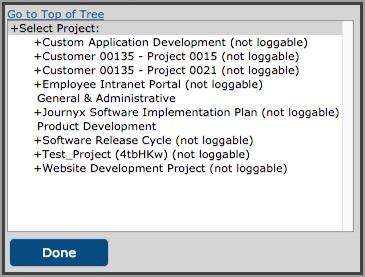
Figure 31.2. Project tree
Inline Tree in Select List
The second method allows you to drill down into the project
hierarchy using a project tree that is included in the project select list itself. If your
administrator has set up your entry screen to include this option, you can navigate down
through the hierarchy of projects by clicking on selections directly in the Project select
list. After each selection, the next level in the hierarchy
is displayed. The final selection that is made prior to save determines the project
to which an entry will be logged.
Project Search
The third method allows you to specify search criteria and select a project from the search
results. To
do a project search, click the Project Search Icon ( ),the
magnifying glass, located to the left of the respective Project select list. This will
launch a pop-up window containing search criteria (see figure 31.3). Specify the project
name or description of the project to be located. As you type, you will see returned search
results below the search criteria. From the search results, you can select the project for
use in a new entry. When you select the project, the pop-up window will automatically close
and the project you selected will appear in the Project select list. Additional search
options are available by clicking on the arrow to expand the Search Options
table.
),the
magnifying glass, located to the left of the respective Project select list. This will
launch a pop-up window containing search criteria (see figure 31.3). Specify the project
name or description of the project to be located. As you type, you will see returned search
results below the search criteria. From the search results, you can select the project for
use in a new entry. When you select the project, the pop-up window will automatically close
and the project you selected will appear in the Project select list. Additional search
options are available by clicking on the arrow to expand the Search Options
table.
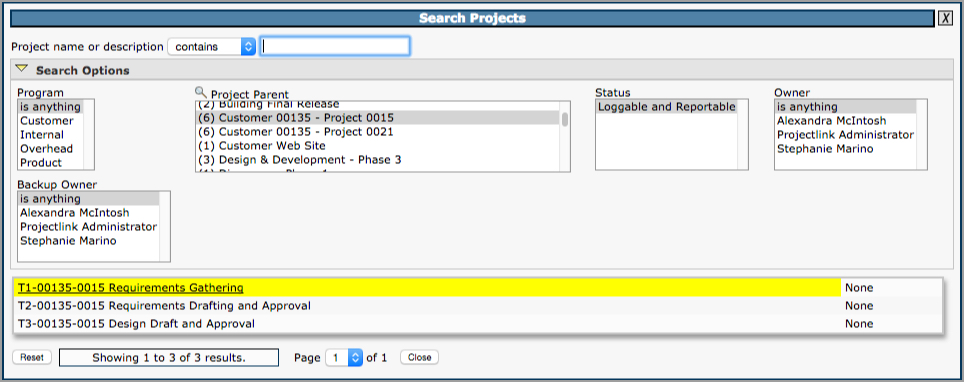
Figure 31.3. Project search
My Project List
You can maintain your own unique list of projects that will be displayed by default in the
project select list. This will keep you from having to routinely locate and select a project
using the other methods when you have a group of projects that you routinely work. The My
Projects link, a number in parentheses next to the Project column label, will launch a
pop-up window that can be used to add and remove projects from your unique Project list (see
figure 31.4). You may add projects from the Available Projects list by selecting the
projects and clicking the Add button. These projects will be added to your project list
shown in the box to the right. To remove a project from your project list, select the
projects and click the Remove button. You also have the ability to add and remove all
projects to and from your Project List. When you are finished, click the Save button.
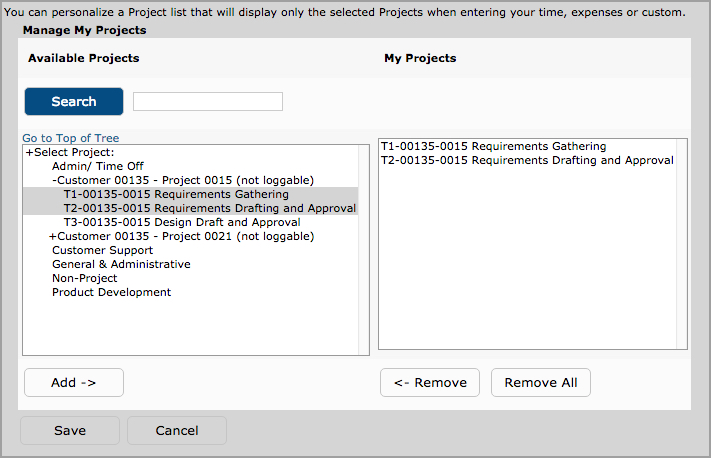
Figure 31.4. My Projects
Memorized Entries
Memorized Entries allow you to save your most common entries so that you do not have to
repeatedly select them when entering custom data. A Memorized Entry contains a single Project,
Location, Item, Unit, and Comment. After an entry has been memorized, it will appear in all your
custom entry screens thereafter. You then only need to enter the amount, if any, for that
entry.
To create a Memorized Entry, select the appropriate Project, Location, Item, Unit, and Comment,
and click the Save button. After the entry has been saved, you will see the Memorize Icon
( ),
a gray star, to the right of the entry. Click the Memorize Entry Icon, review the contents of
the entry as it is displayed on the User Memorized Entries screen, and click Save to preserve
the entry. The information in that entry will be memorized, except for the amount, and will
appear on your custom entry screens thereafter. You can also memorize part of an entry by using
the wildcards feature. Selecting the 'any' value from any of the select lists will not memorize
that field. The same is true when leaving the Comment field blank. When a field is left open as
a wildcard, you can select the value at the time you enter the amount for the memorized entry.
The Project field is not eligible for wildcards and cannot be left open for later selection.
),
a gray star, to the right of the entry. Click the Memorize Entry Icon, review the contents of
the entry as it is displayed on the User Memorized Entries screen, and click Save to preserve
the entry. The information in that entry will be memorized, except for the amount, and will
appear on your custom entry screens thereafter. You can also memorize part of an entry by using
the wildcards feature. Selecting the 'any' value from any of the select lists will not memorize
that field. The same is true when leaving the Comment field blank. When a field is left open as
a wildcard, you can select the value at the time you enter the amount for the memorized entry.
The Project field is not eligible for wildcards and cannot be left open for later selection.
You may also create a Memorized Entry at any time by going to Custom-->Memorized Entries-->Create
Memorized Entry (see figure 31.5). Select a Project, Location, Item, Unit, and Comment. When
finished, click the Save button. The entry will be memorized and will appear on all your custom
entry screens until you delete it.

Figure 31.5. Memorized Custom Entries
To manage existing Memorized Entries, go to Custom-->Memorized Entries-->Manage Memorized
Entries. This screen will show you all the Memorized Entries that you have stored in the system.
These are all the Memorized Entries that appear on your custom entry screen. You can change the
Project, Location, Item, Unit, and Comment for the respective Memorized Entry that you want to
modify. When finished, click the Save button. To delete a Memorized Entry from your custom entry
screen, select the Memorized Entries to delete and click the Delete button.
Previous Entries
The Previous Entries section of the entry sheet shows entries entered in the past if you have
turned on the Previous Entries section under Preferences-->Entry Screens. If you also have
Memorized Entries on your sheet, Previous Entries will be displayed in the same section as
Memorized Entries. Previous entries will continue to show up on each week's entry screen until
you stop logging time against them.
Project Entry Notes
The system allows you to create Project Entry Notes for any custom entry. Project Entry Notes
provide a way for you to record complex comments and information for hours logged in a specific
entry. You can create a Project Entry Note for a specific entry by clicking the gray or yellow
triangle in the lower right corner of the field with the entry amount. A gray triangle indicates
that the entry does not yet have any notes or attachments. A yellow triangle indicates that an
entry has at least one note or attachment. You can hover over the triangle to see what
information exists for the entry. The entry must already be saved in the system before you will
see the gray/yellow triangle. Clicking on the triangle will launch a pop-up window which can be
used to create, edit, or delete Project Entry Notes (see figure 31.6).
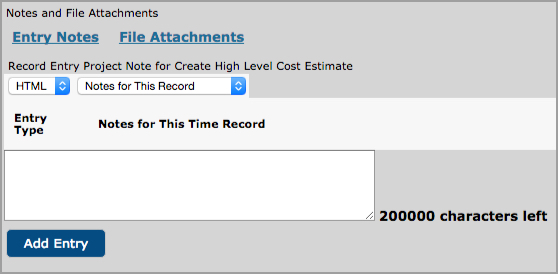
Figure 31.6. Project Entry Note
You can also manage Project Notes and Project Entry Notes under Preferences-->Project Notes.
You can view existing Project and Project Entry Notes by selecting the search criteria and date
range and clicking the Search button. The search results will be displayed below the criteria.
To create a new Project Note, go to the 'Create a New Project Note' section. Select a Project
and enter a note. When finished, click the Save button. Unlike a Project Entry Note, a Project
Note created on this screen will not be associated with a specific entry with an amount and
date.
View Custom Report
The View Custom Report link in the right corner of the gray status bar above the custom entry
grid takes you to a view of your custom entries for the period in report format. You have the
option to display this link or not. You also have the option to pick which custom report will
run when you click this link. Under Preferences-->Entry Screens you can pick the default
custom report that will be tied to the View Custom Report link, or you can remove the link. You
can also modify the default report under Reports-->Standard Reports. See the Reporting section of this user manual for more information on
creating and editing reports.
Sheet History
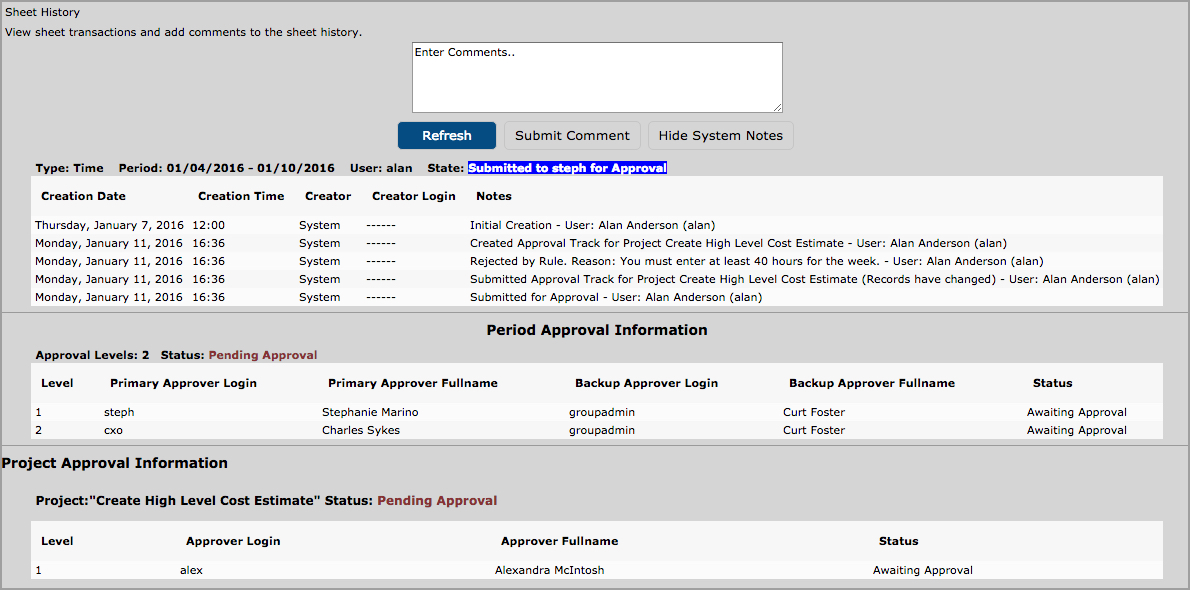
Figure 31.7. Sheet history
Sheet History contains notes regarding a custom sheet for a specific period and the approval
process for that period. The Sheet History link is located in the right corner of the gray
status bar above the custom entry grid. Clicking the Sheet History link will launch a pop-up
window containing all the actions associated with the custom sheet to date. You can insert a
note in the sheet history (i.e., for approvers) by entering the text in the available text box
and clicking the Submit Comment button. To view more details click the Show System Notes button.
This will display the system notes that correspond to the actions associated with the custom
sheet. To hide the system notes, you can click the Hide System Notes button.
Uploading File Attachments

Figure 31.8. File attachments
If your administrator has given you access to upload attachments, you will see gray or yellow
triangles in the lower right corner next to the amounts for existing entries. Before you can
upload files, you must create some custom entries and save changes. After creating entries,
click the gray or yellow triangle next to the amount of the entry for which you want to add an
attachment. A gray triangle indicates that the entry does not yet have any notes or attachments.
A yellow triangle indicates that an entry has at least one note or attachment. You can hover
over the triangle to see what information exists for the entry. Clicking on the triangle will
open a pop-up window that shows links for Entry Notes and File Attachments. Click on the File
Attachments link, and a list of your current custom entries will be displayed. Find
the entry you want to use. Then click the Upload File Attachment link. Click the Choose File
button and select the attachment from your local computer files. Then click the Attach File
button to complete the process. You can upload
multiple attachments per custom entry as long as they each have a different file name. Your
administrator may choose to limit the total number of attachments or the type of files allowed.
For example, the administrator may only allow PDF files. The administrator may also set a limit
on the size of individual files. You can delete an attachment by clicking on the trash can icon
next to the file name. When you are finished managing your attachment, click on the Close This
Window button.
Submitting Custom Data for Approval
If you are assigned to a custom approval plan, you can click the Submit for Approval button to
submit your custom data to your supervisor for the sheet period. Once your custom data has been
submitted for approval, you may not alter any of the entries on the submitted sheet. Therefore,
do not submit your custom data until you have finished all entry for the time period in
question. If you discover that you need to make a correction after the sheet has been submitted,
contact your approver and have the sheet rejected so that corrections can be made. For more
information on the Approvals process, please see the Approvals section of this manual.
Custom Entry Corrections
When an entry is changed on an entry screen, it can be handled in several different ways
depending upon the state of the sheet and the system setting for "Level of auditing required
when users make changes to existing entries." Most of the time, you will not be aware of what
the database is doing with changes as you make them. It will simply handle the changes "under
the hood" as you update your entries. If your administrator has set your audit level to 3 or 5,
you will be required to enter a reason for changing an existing entry on either a submitted or
open sheet. Sheet status must be open or rejected in order to make changes.
Administrators and users whose role includes the Prior Period Corrections ability can make
changes to entries on approved sheets. For these users, the Save Corrections button will appear
on approved sheets. When this button
is present, corrective entries can be entered in the blank rows at the bottom of the screen.
Historical Custom Sheets
Your past and present sheets can be viewed under Custom-->Custom Sheets-->All Custom Sheets
(see figure 31.9). Here you will see a list of sheets based on the dates of the periods. You can
view the details of each sheet by clicking on the Click to View link.

Figure 31.9. Historical custom sheets









